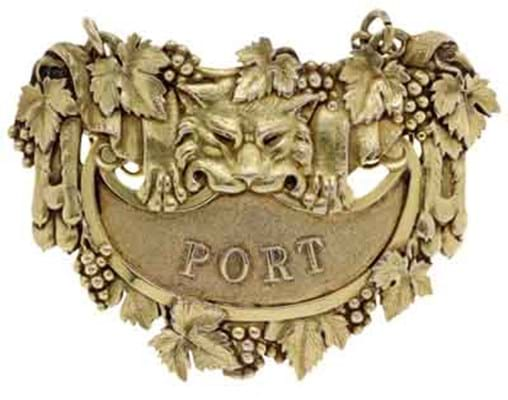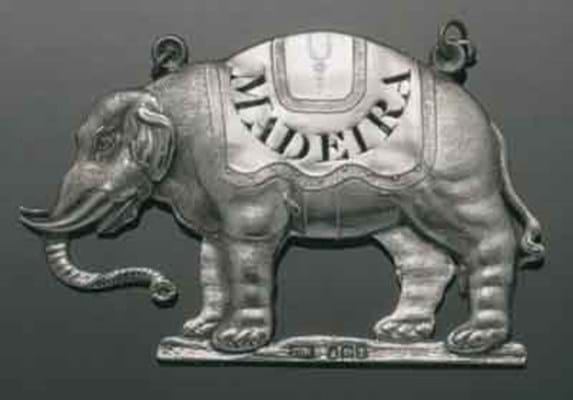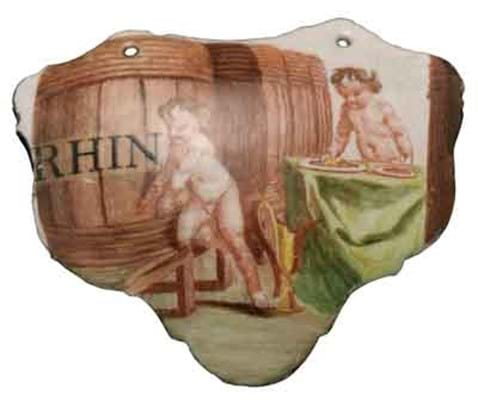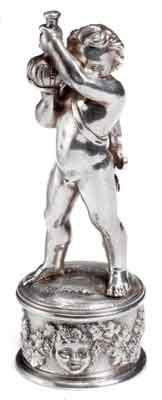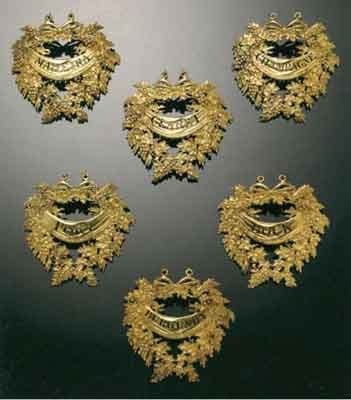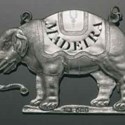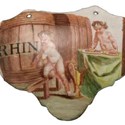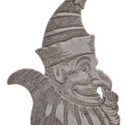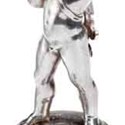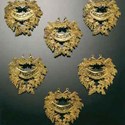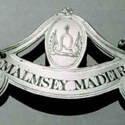Their first purchase - a harlequin set of four rectangular decanter labels of various dates and makers bought from an antiques shop in Dorchester, Dorset in 1961.
Collecting 'bottle tickets' was "the perfect excuse to explore antique shops and markets wherever in the world we happened to be" and the perfect souvenirs of foreign travel: "easy to transport, basically unbreakable and bearing the hallmarks that could prove their antiquity to customs officials."
The Lank collection of wine labels was offered in 201 lots by Bonhams Knightsbridge (20/12% buyer's premium) on October 5 - a chance for fellow members of the Wine Label Circle to inspect, and do battle for, the fruits of 50 years of collecting.
As the collection came from outside Europe, all bids incurred an additional five per cent VAT on the hammer price. Ergo, when the buyer's premium and other extras were added, the bidder who successfully tendered £100 for an oval form bright-engraved hock wine label (IP, London 1817) could expect a bill of £130.
From this grass roots level, prices for hallmarked silver labels rose to £2400 for one of the most celebrated of all Paul Storr labels, the silver gilt 'lion's pelt' design influenced by a detail on The Warwick Vase.
In John Salter's recent work Wine Labels 1730-2003 A Worldwide History, it states that the design was first produced in 1812, although this example for port was marked for 1810, so a little revision may be necessary. It sold for £2400 (estimate £2000-3000).
There was a steady demand for the grander Regency and William IV cast labels by leading London makers.
Sherry labels by Paul Storr included a William IV (1835) silver-gilt scallop shell form label with incised title (estimate £1000-1500) and a George III (1816) silver label of shaped oval form with shell and leaf borders (estimate £600-800). They took £1900 and £1200 respectively.
The so-called 'Lady Bountiful' design is one of Charles Rawlings's most original labels. Although it is not known quite who she is meant to represent, the winged figure with a generous bosom provides a perfect foil for the label she clutches in her outstretched arms. The example here for madeira, marked for Rawlings, London 1832, took £850 (estimate £700-900).
A George III silver cast madeira by Benjamin Smith, London 1807 formed as a four leaf clover with engraved title took £1600 (estimate £800-1200) - an early version of this model and substantially more expensive than a parcel gilt label of 1808 seen at Woolley & Wallis in 2003 (£740) or the silver version by William Cooper (1846) sold by the Salisbury rooms this July for £700.
However, there was a muted response to a rare label modelled as an elephant and howdah by Daniel Hockey, 1813. This desirable madeira label has sold for sums well above the £1200-1500 estimate awarded here (one took a mighty £4600 at Woolley & Wallis in 2004) but this one could manage just £1000.
The absence of the town mark and the possibility of a repair to a tusk were small imperfections: the current availability of a number of these labels on the market was more of an issue.
Are prices falling in some areas? In a collector-dominated market some volatility is not unusual.
Once guaranteed to bring close £1000, but sold here at the lower end of a £400-600 estimate was a silver port label in the form of a bat with outspread wings.
There are various theories of the origin of these curious (and typically unmarked) labels but most agree on an Eastern colonial source, either China or India. Wine Labels 1730-2003 clearly favours a Chinese origin, noting that "the bat is a potent symbol of longevity and happiness in Chinese iconography while it would appear not to feature in Indian symbolism."
Prices were stronger for the less sophisticated English, Scottish and Irish labels carrying provincial assays. Here the market broadens to include collectors of regional silver.
Newcastle hollowware does not always carry a significant premium over the other metropolitan assays but a pair of Geordie wine labels is a rarity. Struck for Robert Pinkey c.1790 these kidney-shaped labels with open-work ends and incised titles took £750 (estimate £300-400).
Gin label
A Scottish provincial gin bottle ticket, cut and bright-engraved as a 12-point star by Edward Livingstone, Dundee, c.1795 took £800 (estimate £600-800); a George IV oval form port label with marks for Joseph Fowler of Exeter, 1828 took £450 (estimate £120-150) while a finely engraved rectangular madeira label with the maker's mark only for Mary Huntingdon, Chester brought £850 (estimate £180-220). Bidding for a pair of narrow rectangular form port and claret labels with wrigglework borders struck for Carden Terry and Jane Williams of Cork, c.1810 reached £720 (estimate £300-400).
A particularly rare label for port, with the maker's mark only for James Phipps c.1780, included a cut-out harp surmount and the inscription to the reverse It's New Strung and will be heard.The same inscription (the rallying cry of the late 18th century United Irishmen movement) was seen to a White Wine label sold in these rooms for £1750 as part of the John Beecroft collection in 1998. Estimated at £700-900, it sold particularly well at £2100.
Two good crescent-form examples carrying the maker's mark only for Hester Bateman, a collectable name in her own right, sold at £420 and £380 respectively. The former, a claret label with open chainwork swags and an urn surmount dated from c.1775, the latter with an unusual pierced zig-zag border and the incised titledWhitefrom around 1790.
Susanna Barker, a specialist label maker, was represented by a White Wine label c.1780 with pierced scroll-work and a crested oval and wreath surmount. It did particularly well, knocked down at £550 (estimate £180-220).
Sharing an unusual form with an unusual title, a S[mall] Beer label, probably by William Turton c.1770 took £900 (estimate £300-400). A similar example incisedLisbon,sharing a crest suggesting they are possibly from the same set, was sold for £300 as part of the Beecroft collection 12 years ago.
Other unusual titles included a handsome crested label (maker's mark WR) for Malmsey Madeira that trebled hopes at £620 and an otherwise unexceptional Victorian canted rectangular label (A.G. Peisse, London 1867) with the pierced title Manzanilla sold at £320. The latter, one of a number of brews that had the Lanks "scurrying for the dictionary" is Spanish for 'little apple' and a variety of fino sherry.
The Lanks owned relatively few enamel wine labels (or, indeed those of ivory, ceramics, mother of pearl or the other materials commonly used in their manufacture), but the half a dozen examples included a very fine example made by the Battersea factory at York House in its short life between 1753-56. Despite some patches of restoration, it sold at £3000 (estimate £2000-3000).
A total of 17 different designs and some 40 different titles have been recorded: this printed and painted design engraved by Ravenet after a design by James Gwin, depicts two putti by a row of large barrels, one filling a ewer from a tap, the other laying food on a table. Titled Rhin,this label is also found titled Ale and Hock (as seen to the label also sold by Bonhams in 2005 for £3000).
In the final analysis, 69 per cent of the 201 lots got away for a total of £65,355.
It was rather more unsold lots than auctioneer and client would have liked but, like any large collection, there were the ordinary examples to which the market is price sensitive and one or two good things that the vendors were reluctant to sell at anything other than decent money. A handsome George IV silver gilt cast claret bottle collar by John Bridge, unsold at its £2500-3500 guide, was a case in point.

